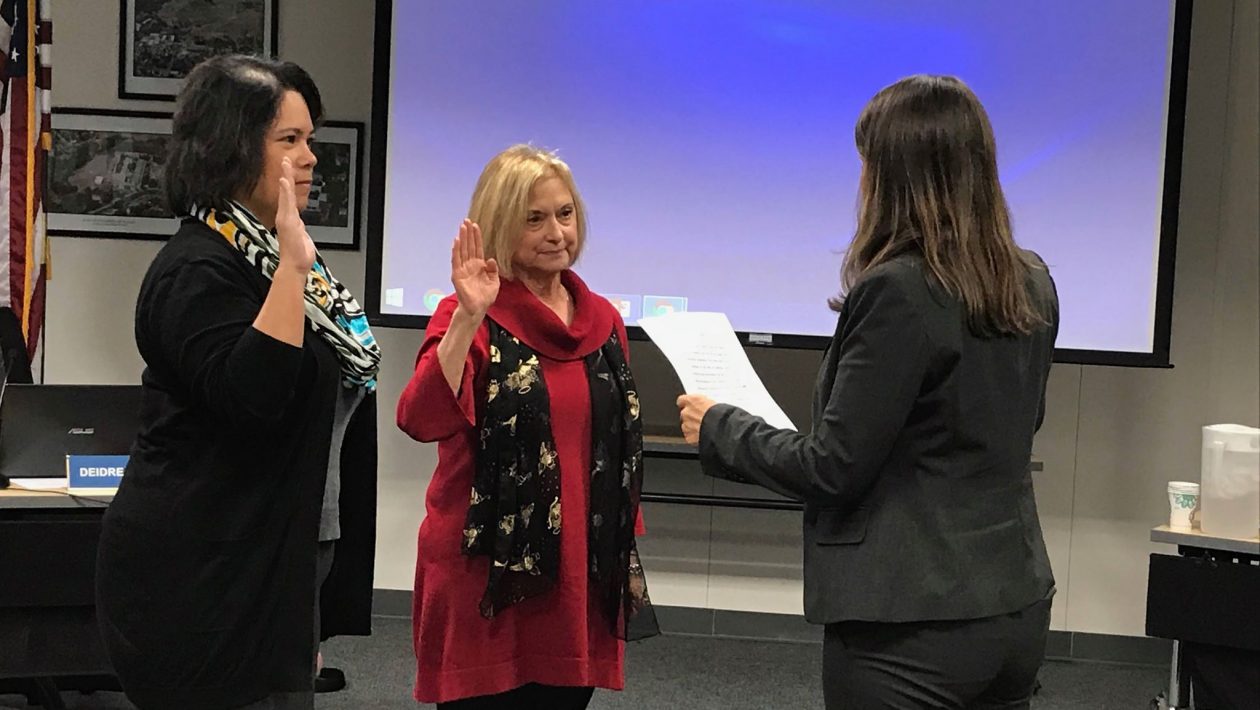MARTINEZ, Calif. – Martinez Unified School District Board of Education chose the design-build team Monday that will rebuild the John Muir Elementary School campus.
Lathrop Construction Associates and HKIT Architects were hired to the job for no more than $29,842,624 under the two-step design-build approach to construction.
The Board decided in April to use that method to lock in a price earlier than it could under other systems, and because it might get the campus overhaul finished more quickly.
The team’s offer is less than earlier estimates of about $33 million, and will keep the district clower to its proposed expenditures of Measure R bond money.
The new campus will have a single building with long, central corridors. Traffic flow and parking also will be redesigned.
The outgoing Board president and newly elected clerk, Jonathan Wright, said he was “proud to be discussing and voting on this. I devoted a huge amount of my life to this.” Other members and District staff has been working on it even longer, he said.
He was pleased to see several firms apply for the project, and was equally pleased the Board had approved a Project Labor Agreement that, on larger projects, requires nonunion contractors to pay into unions and prevents hired contractor employees from participating in work stoppages.
In addition, area labor organizations agreed to certain provisions, including those about local hiring and reaching out to students through programs that could welcome them into the various construction industries.

The Board chose Deidre Siguenza, who was re-elected in the Nov. 6 election, as its next president and Bobbi Horack, who was unchallenged for her return, as vice president.
In other matters considered Monday, Tom Doppe, director of Educational Services, introduced the Board to the latest California School Dashboard report for the District and its individual schools.
The Dashboard has been released to the public and is available online at https://www.caschooldashboard.org/reports/07617390000000/2018.
The District has 4,160 students, of which 29.3 percent are socioeconomically disadvantaged, 8.7 percent speak other languages and are learning English and 0.3 percent are foster children.
The Dashboard has been redesigned, changing from a series of pie charts to a gauge that ranges in colors from red, that indicates a significant decline; through orange, indicating a lesser decline; yellow, representing maintaining; green, indicating an increase; and blue, representing a significant increase or improvement in performance.
Among the bright points of the report, the District had a “highest performance,” or blue gauge color, for showing a 14.3 percent improvement, to 57.5 percent, in students who are prepared for college or a career upon graduation. That’s better than California’s rate of 42.2 percent of graduates prepared for college or careers.
Another bright spot is in graduation rates, Doppe said. Although the district had a slight drop of 0.6 percent, it has a graduation rate of 91.9 percent, the state evaluation showed. By comparison, California overall has a graduation rate of 83.5 percent.
Other gauges showed where the District still has more work to do.
In English language arts, the District declined 5.4 points to 1.9 points below standard, although California overall ranks 6 points below standard. The District’s mathematics ranking is even lower, 25.6 points below standard, compared to the state’s 36.4 points below standard.
The District has 6.2 percent identified as chronically absent, and suspended at least 4.6 percent of its students at least once. The state’s absenteeism is ranked better, but its suspension evaluation is about the same.
Breakdowns also are available for individual schools as well as students in a variety of demographics, Doppe said. “There’s a lot of information here,” he said. He called the Dashboard graphics “the District at a glance.”
Doppe also described modifications to Single Plans for Student Achievement for the District’s elementary schools, Martinez Junior High School, Alhambra and Vicente High Schools and Briones Independent Study School.
Those plans show how the district spends its money to achieve its goals, such as education, positive student behavior and regular attendance.
Auditor Christy White, of Christy White Associates, gave the District high marks for its 2017-18 overall annual financial audit report as well as Bond Measures K and R, a report the Board unanimously accepted.
Changes for liability for the California Public Employees Retirement System (CalPERS) and the California State Teachers Retirement System as well as entries for employees’ health insurance meant those numbers were higher than in the past, White said.
But the overall trends are positive, she said. “You are maintaining your reserves.”
She said the gave the overall financial picture a “clean” label, with one correction in attendance accounting. She had no corrections for the bond measures’ audits.
Assistant District Superintendent Helen Rossi presented the first interim report on the 2018-19 budget, a revision to the document the Board adopted before the summer break. This report covers the District’s finances from July 1 to Oct. 31.
This first report doesn’t include raises given to employees who are members of the California School Employees Association, and those will be reflected in the next update, Rossi said. But it does show the changes caused by raises to other employees whose contracts were ratified earlier.
Just as the audit showed, the two retirement systems’ costs have increased, she said. On the other hand, the District’s share of California lottery money is stagnant.
Salaries make up the largest portion of District expenditures, and while those have gone up, other expenses have declined, such as books and supplies. So far, expenditures are $1.5 million lower, but that will change as the CSEA employees’ raises are factored in during the next reporting quarter, she said.
Through cost-cutting measures that have eliminated $500,000 from this and future budgets, the District will be able to maintain reserves in excess of the 3 percent minimum.
So far, it appears the current fiscal year should end with 11.39 percent in reserves, Fiscal Year 2019-20 should end with 8.53 percent in reserves, and Fiscal Year 2020-21 should finish with 4.81 percent, although that could drop as low as 3.81 percent.
Members of both the District staff as well as the Board expressed frustration with the way California funds education. For instance, District Superintendent C.J. Cammack noticed that the increases in CalPERS and CalSTRS are far greater than the cost of living increases.
“I wish we had more creative solutions in the budget,” he said. “We need to do a better job funding education in California.”
Boardmember Kathi McLaughlin said she was watching to see how the incoming governor, Gavin Newsom, would address the matter. That was addressed in the latest issue of the California School Board Association’s magazine. McLaughlin represented the District at the CSEA level for 10 years, and expressed her disappointment that no one from MUSD has succeeded her.
Horack also read the article, which said the state has $15 billion in reserves but hasn’t used that money to fund public education. “That’s more than enough for a rainy day,” she said.
Wright was similarly frustrated, saying the local district was struggling with a deficit budget while solutions could be provided in Sacramento. “It’s outrageous,” he said.





